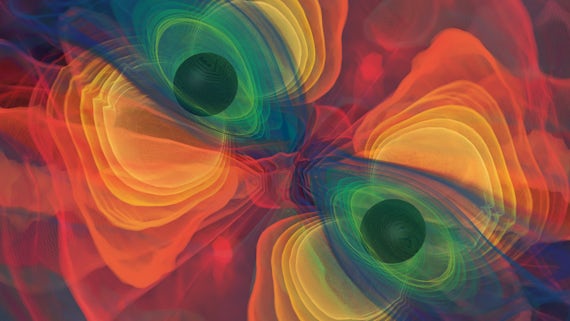Improving sensitivity for Advanced LIGO
Detector operations
We support the use of giant laser interferometers to search for gravitational waves.
Laser Interferometer Gravitational Wave Observatory (LIGO) is the world's largest gravitational wave observatory. Comprised of two enormous laser interferometers located thousands of kilometers apart, LIGO is used to detect and understand the origins of gravitational waves.
The lasers must be made to resonate between the mirrors of the detector arms in order to make a measurement. This is called having the detector locked.
Any interference in this process — from seismic vibrations, electronics, temperature or pressure changes, to name a few — can produce noise that limits the sensitivity of the detectors to gravitational wave signals. They may even cause a locked detector to lose lock, and stop science observations.
Our research
To stop interference from happening we study the data coming out of the instrument to see if we can link any of the noise to a specific component or section of the interferometer, or attribute it on an external influence like the weather or human activity.
This allows us to either tweak the instrument or label the data as 'noisy' so that these noise features don't ruin analysis that could potentially contain real gravitational wave signals.
Related publications
- Aasi, J. et al., 2015. Characterization of the LIGO detectors during their sixth science run. Classical and Quantum Gravity 32 (11) 115012. (10.1088/0264-9381/32/11/115012)
- MacLeod, D. et al. 2012. Reducing the effect of seismic noise in LIGO searches by targeted veto generation. Classical and Quantum Gravity 29 (5) 55006. (10.1088/0264-9381/29/5/055006)
- Aasi, J. et al., 2012. The characterization of Virgo data and its impact on gravitational-wave searches. Classical and Quantum Gravity 29 (15) 155002. (10.1088/0264-9381/29/15/155002)
- Smith, J. R. et al., 2011. A hierarchical method for vetoing noise transients in gravitational-wave detectors. Classical and Quantum Gravity 28 (23) 235005. (10.1088/0264-9381/28/23/235005)
We have also participated in attempts to understand the behaviour of gravitational wave detectors and thereby improve their performance:
Nuttall, L. K. et al., 2015. Improving the data quality of Advanced LIGO based on early engineering run results. Classical and Quantum Gravity 32 (24).
Adams, T. et al., 2015. Cost–benefit analysis for commissioning decisions in GEO 600. Classical and Quantum Gravity 32 (13).
Improving the electronics of the gravitational-wave readout for Advanced LIGO
Advanced Laser Interferometer Gravitational Wave Observatory (LIGO) detectors are extremely complex instruments with sensitivities reaching as low as 2×10-20 m/sqrt(Hz) during operation. To accomplish better astrophysical sensitivity, the instruments are continuously upgraded, applying state-of-the-art technologies during break-time in the year-long observing runs.
The quantised nature of light poses one of the most significant barriers on the improvement of LIGO's sensitivity, with increased power and squeezed states of light being part of the LIGO A+ upgrade (a detector upgrade planned after the next observing run, O4) to reduce the shot noise and radiation pressure present within the system. However, decreasing shot noise with squeezing increases the relevance of other noise sources, specifically that of the electronic noise of the main photodetector readout. To tackle this and allow the use of higher levels of squeezing, a new high-power and low-noise preamplifier circuit for the photodiode readouts has been developed. These preamplifiers are the very first step to extract the gravitational wave signals from the photodiodes. When gravitational waves pass the detector, the photodiode in transmission of the output mode cleaner senses the slight power change of the laser light. The preamplifier then converts the photocurrent signals of a photodiode to a voltage and amplifies those signals.
The new readouts have been developed with the aim of being installed at Hanford and Livingston in time for the 2022 observing run. The final design shows noise level reductions up to a factor of 6 compared to the current readout (Fig. 1) which will increase the amount of observed squeezing upon installation and thereby increase the sensitivity of the LIGO detector to astronomical mergers further out into the universe.

LIGO scientists detect gravitational wave signal from the merging of two black holes.


